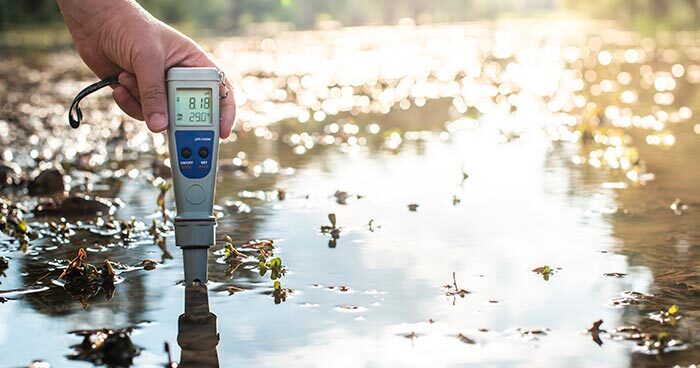Water bodies are the source of life on Earth. We cannot imagine our lives without freshwater and its many benefits. A plethora of physical, chemical and biological elements impact the quality of water in bodies such as ponds, lakes, streams, rivers and oceans, not to mention groundwater.
Every human being and living creature has the right to use unpolluted water, making it essential to evaluate water quality regularly. Water quality means how safe or clean a body of water is to use. It includes physical, chemical, and biological factors which can affect our health if we consume polluted water.
The composition of pollutants in a body of water can vary from place to place. Therefore, it is essential to assess the water quality in different bodies to use them safely and prevent any illness or disease. Effective and pre-emptive water-quality testing and monitoring strategies can help professionals to evaluate water quality safely and efficiently. This blog post will outline the basic steps for water quality evaluation. So let’s dive in.
Click here – What Is Flygon Weak Against?
CDOM and FDOM Monitoring
Monitoring the levels of chromophoric dissolved organic matter (CDOM) and fluorescent dissolved organic matter (FDOM) can help you evaluate the water quality near you. The presence of these particles in the water is often an indicator of pollution, particularly from wastewater discharges. Understanding how they are measured and monitored can help you assess water quality quickly and accurately.
In particular, looking at the colour and fluorescence levels helps identify situations where further investigation or remedial action may be necessary so that you can ensure our water stays healthy for generations to come. Some water associations also measure the amount of suspended particulate matter. It is important to ensure that the water is free of these, as they can be carriers of harmful bacteria.
Chlorophyll Fluorescence Analysis
Chlorophyll fluorescence analysis has become an incredibly useful tool when evaluating water quality. This assessment assesses plant-centre photosynthesis and works by measuring the intensity of light emitted from the leaves, allowing us to gain information on the rate of photosynthesis.
Unlike conventional water testing methods, chlorophyll fluorescence assessment provides moment-by-moment information that gives more accurate readings. It can also be programmed with sensors to work autonomously in remote areas making it an ideal testing method for hard-to-reach spots.
The presence of algae, nitrate, and phosphate can all be assessed with this method, helping us understand the health of our water bodies. Like marketing your HVAC company, water treatment business also requires understanding customer needs, evaluating water quality requires understanding the environment, which can be provided by chlorophyll fluorescence.
Conductivity, And TDS Monitoring
Conductivity and total dissolved solids (TDS) are two of the most important parameters to measure water quality. Conductivity measures the capability of a liquid or solution to conduct an electrical current, while TDS is a measure of all inorganic and organic substances found in water.
These measurements can help us detect any changes in our water and be useful for ensuring the water is safe to drink or use. Additionally, they give us insights into the overall health of our bodies of water so that we can take appropriate actions if needed. Analyzing water quality with these parameters is becoming increasingly important with the growing need for clean water sources.
Record Water Temperature
Evaluating water quality isn’t something to take lightly; without proper knowledge, equipment, and safety gear, you might get more than you bargained for! One of the most important steps in any water evaluation is taking note of the temperature.
Whether you use thermometers, a drone equipped with a thermosensor, or your Chewbacca-level body heat, make sure to pay attention to the temperature of the water so that you can gain an insight into what’s living inside it.
Too hot or too cold can mean trouble for aquatic life, affecting everything from biology lessons to streamside picnics. Temperature control is related to many other parts of water utilization and conservation, from preventing harmful algae blooms to controlling hazardous levels of chemicals or sewage overflow. Doing your bit in evaluating and keeping records on water temperature helps keep everyone safe from head to toe.
Click here – What Is Core Muscle Surgery?
Measuring pH And KH
Water’s pH and KH (carbonate hardness) are other important parameters when assessing water quality. pH stands for potential hydrogen; it measures the acidity or alkalinity of the water and is measured on a scale from 0-14.
The higher the number, the more basic or alkaline your water sample is. On the other hand, KH is also referred to as carbonate hardness, and it measures the presence of buffering minerals such as calcium and magnesium in your water.
It’s important to monitor these parameters because if they are too high or low, they can affect the life within the ecosystem you’re observing. If any water body is too acidic or too basic, it can make the environment unsuitable for fish and other aquatic life.
Measuring Dissolved Oxygen Levels
One of the most important elements of evaluating water quality is measuring dissolved oxygen levels. If dissolved oxygen levels start to decrease in a body of water, this can indicate a serious problem. Signs of low dissolved oxygen levels include a fish die-off, foul odours, and the presence of certain forms of algae.
Fortunately, evaluating water quality is fairly straightforward. Oxygen levels can be tested with probes, sondes, and other specialized testing equipment, usually obtainable from laboratory supply companies. Once you know your baseline oxygen level for different times and places within a body of water, you can compare results over time, allowing you to stay on top if something starts to change.
